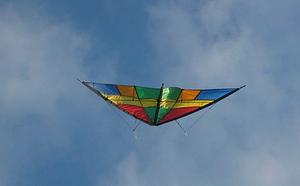EnergyStunt kites raise wind power to another level
Researchers are sending stunt kites into the skies to harness the wind and convert the kinetic energy generated into electricity; the kites fly at a height of 300 to 500 meters, positioned to be caught by strong winds; cables, about 700 meters in length, tether the kites to vehicles and pull them around a circuit on rails; a generator then converts the kinetic energy of the vehicles into electricity

Stunt kite in flight // Source: commons.wikimedia.org
It may seem as though the German plains are all but tapped out when it comes to wind energy production. To refute this theory, researchers are sending stunt kites into the skies to harness the wind and convert the kinetic energy generated into electricity.
Kite surfing has risen to become a fashionable sporting activity, with the number of enthusiasts participating in this cross between wind surfing and stunt kite flying growing at a tremendous pace. When the wind catches the kite, the surfer is carried meters into the air; and the greater the leap, the bigger the thrill. A modern stunt kite, however, is capable of being much more than a mere piece of sporting equipment — it has the potential to become a valuable energy producer. A stunt kite’s aerial movements can be used to drive a generator, which in turn converts this kinetic energy into electricity. A Fraunhofer release reports that this dynamic idea came to the founders of Berlin-based wind energy developer NTS GmbH. To make their concept a reality, they brought in the Fraunhofer Institute for Manufacturing Engineering and Automation (IPA) in Stuttgart. The project partners intend to use their new method to harness the power of strong winds at altitudes of up to 500 meters.
Joachim Montnacher, an engineer at the IPA, explains how a “kite power station” works thus: “The kites fly at a height of 300 to 500 meters, perfectly positioned to be caught by strong winds. Cables, about 700 meters in length, tether the kites to vehicles and pull them around a circuit on rails. A generator then converts the kinetic energy of the vehicles into electricity. The control and measuring technology is positioned on the vehicles.” Compared to conventional wind farm technology that relies on rotors, this technology offers a wide range of advantages. Wind speeds at ground level tend to zero, but they increase dramatically the higher you go. At a height of 100 meters wind speeds are around 15 meters a second; at 500 meters they exceed 20 meters a second.
“The energy yield of a kite far exceeds that of a wind turbine, whose rotor tips turn at a maximum height of 200 meters. Doubling the wind speed results in eight times the energy,” says Montnacher. “Depending on wind conditions, eight kites with a combined surface area of up to 300 square meters can equate to 20 conventional 1-megawatt
